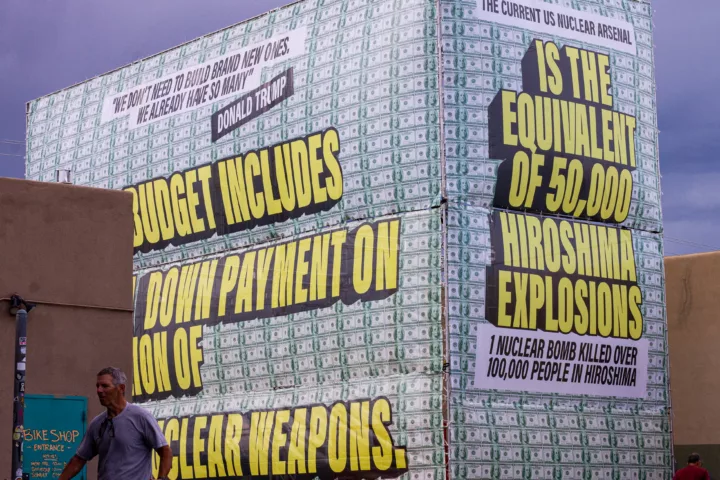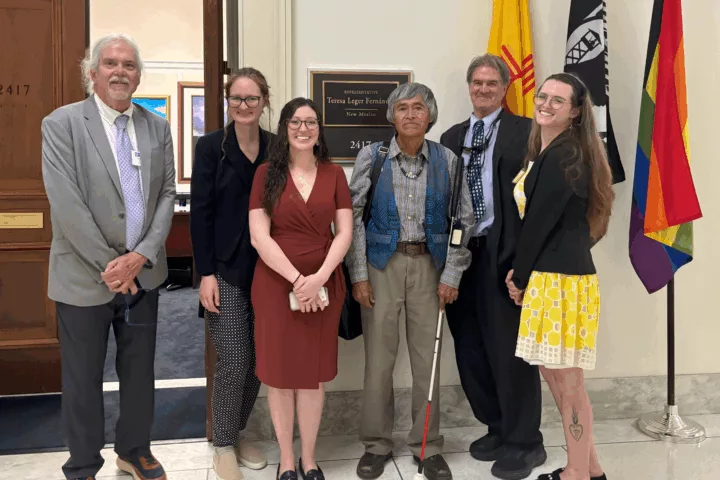The much-quoted ex-Sandia director Paul Robinson was prominent in undermining U.S. ratification of the long-sought-for Comprehensive Test Ban Treaty by damning it with faint praise in 1999 congressional testimony. The CTBT failed, but the labs kept the quid pro quo money for so-called Stockpile Stewardship. There is hardly a nuke that Robinson doesn’t like. In the past, he argued for a “To Whom it May Concern” target list (fill in the blank) for U.S. nuclear weapons.
Finally, the 900 pound gorilla. This article has no mention of U.S. plans to spend at least a trillion dollars over the next 30 years on “modernization” of nuclear forces. This will rebuild every existing type of nuclear weapon in the planned stockpile, and buy completely new missiles, subs and bombers to deliver them. That makes Putin look like a chump.
You bet that the for-profit, giant defense contractors running the Los Alamos and Sandia Labs (Bechtel and Lockheed Martin) and their politicians are closely watching deteriorating relations with Russia (which the U.S. has done so much to cause). They can hear the cash registers going ca-ching, ca-ching! Meanwhile, as schools and bridges are falling apart and the 70th anniversaries of the Hiroshima and Nagasaki bombings approach, the nuclear weapons labs are internally trumpeting “The Second Nuclear Age.”
Jay Coghlan,
NukeWatch Director
[need subscription]
Putin’s plans to add nukes closely watched in New Mexico
By Michael Coleman / Journal Washington Bureau
PUBLISHED: Sunday, June 21, 2015 at 12:02 amWASHINGTON – Russian President Vladimir Putin’s announcement last week that he plans to add 40 new intercontinental ballistic missiles to his country’s nuclear arsenal could have implications for New Mexico’s nuclear weapons laboratories and the spending debate on Capitol Hill.
Putin’s announcement was a blunt reminder of Russia’s nuclear might amid tensions with the West over Ukraine.
Relations between Russia and the West have plunged to their lowest point since the Cold War with Moscow’s annexation of Ukraine’s Crimean Peninsula and support for a pro-Russia separatist insurgency in eastern Ukraine.
“Over 40 new intercontinental ballistic missiles capable of penetrating any, even the most technologically advanced, missile defense systems, will join the nuclear forces in the current year,” Putin said.
The declaration came at the opening of an arms show at a shooting range in Alabino, just west of Moscow. Sen. Tom Udall, a New Mexico Democrat and member of the Senate Appropriations Committee, said Putin’s nuclear weapons declaration was troubling.
“Putin’s military aggression is disturbing on a number of fronts,” Udall told the Journal. “A nuclear conflict should never occur in today’s world, and the U.S. and Russia should continue to commit to our agreements to reduce these weapons and prevent proliferation to additional countries.”
Russia’s nuclear developments are likely to be closely watched by workers at Sandia and Los Alamos national laboratories.
“These developments do underscore the importance of the work at our national nuclear labs, which keep the nation’s arsenal safe, secure and reliable, and provide critical capabilities to track and prevent proliferation,” Udall said.
UDALL: This military aggression is “disturbing”UDALL: This military aggression is “disturbing”
Last year, Russia added 38 ICBMs to its arsenal, according to Defense Minister Sergei Shoigu. Modernizing its nuclear forces is a top priority for the Russian military, which needs to gradually decommission its aging Soviet-built ICBMs.
No violation
Nuclear policy experts interviewed by the Journal this week said the addition of the nuclear weapons would not put Russia in violation of the 2010 New START agreement, in which the U.S. and Russia both agreed to nuclear weapons limits.
“Putin’s move is mainly symbolic, because 40 more ICBMs does not significantly affect the strategic balance and keeps Russia within the limits of the New START agreement,” said Gary Samore, who served for four years as President Barack Obama’s White House Coordinator for Arms Control and Weapons of Mass Destruction.
Rodney Wilson, director of nonproliferation programs at Sandia, referred the Journal‘s questions about implications for the New Mexico lab to the National Nuclear Security Administration, which oversees the labs.
An NNSA spokeswoman also declined to comment on the labs’ work related to Russian nuclear arms issues and instead referred the Journal‘s questions to the State Department or the White House.
White House spokesman Josh Earnest dismissed Putin’s pledge to build more nuclear weapons as “saber-rattling” and said it “does nothing to de-escalate conflict.”
“The United States has repeatedly stressed our commitment to the collective defense of our NATO allies,” Earnest told reporters at the White House this week. “That is a commitment that we are willing to back up with action, if necessary. And that stands in pretty stark contrast to the saber-rattling that we’ve seen from Mr. Putin.
“And you could also make a case – and I think with some credibility – that invoking the nuclear arsenal is even an escalation of that saber-rattling,” Earnest added. “That’s unnecessary and not constructive.”
The U.S. and the EU have slapped Russia with economic sanctions, and Washington and its NATO allies have pondered an array of measures in response to Russia’s moves toward Ukraine. The three Baltic members of the alliance – Estonia, Latvia and Lithuania – have asked NATO to permanently deploy ground troops to their nations as a deterrent against an increasingly assertive Russia.
And Polish Defense Minister Tomasz Siemoniak says he and U.S. Defense Secretary Ashton Carter have held talks about placing U.S. heavy army equipment in Poland. The uptick in Russia’s nuclear ambitions would seem to stymie President Barack Obama’s call for a nuclear-free world during a much heralded 2009 speech in Prague in which Obama vowed “America’s commitment to seek the peace and security of a world without nuclear weapons.”
Asked whether there is a possibility of another U.S.-Russian arms race, Earnest suggested that Russia – hit hard by falling energy prices – may not be able to afford Putin’s latest nuclear pledge.
“There are legitimate questions that have been raised about whether or not Russia would be able to succeed in following through on many of the claims and threats that President Putin has had to offer,” Earnest said.
Work at labs
Paul Robinson, a former director of Sandia National Laboratories, said Putin’s announcement last week reinforces the importance of the work done at Sandia and Los Alamos, which are integral to the nation’s nuclear weapons complex.
Both labs are heavily involved in maintaining the nuclear stockpile, and working to prevent the spread of nuclear weapons and materials around the world.
ROBINSON: Concerned about a new weaponROBINSON: Concerned about a new weapon
“Nuclear deterrence is just as important as it ever was, and to say we’re going to relax and we don’t have to worry about strategic war any more would be a huge mistake,” Robinson said in a Journal interview, adding that he is concerned about Russia’s reported work on developing a new tactical nuclear weapon that would emit low radiation and could be used in conventional warfare.
“I think it is time for us to worry about it,” said Robinson, who was an ambassador and chief negotiator during U.S.-Soviet nuclear arms talks in Geneva in the 1980s.
“Clearly, if these things are going to arise again to threaten our future, (the labs) would do almost anything they could in being a part to protect it.”
Steven Pifer, director of Arms Control and Non-Proliferation Initiative at the nonpartisan Brookings Institution, said Putin’s announcement might trigger additional sympathy for nuclear weapons spending on Capitol Hill. Nuclear weapons budgets remain steady – including for work on the B61 Life Extension Project carried out at both New Mexico labs – but some in Congress are questioning the need for increases.
“My guess is that it might increase a little bit the push for doing more on the nuclear side, but I don’t think it’s going to have a huge impact,” Pifer said.
“The more worrisome thing is, why does Putin feel the need to keep talking about nuclear weapons? I sincerely hope he does not see these things as weapons of coercion, because that could be potentially very dangerous. I hope there are sensible people around him who are explaining to him just exactly what one should do to manage nuclear weapons in a responsible way.”
The Associated Press contributed to this report.


